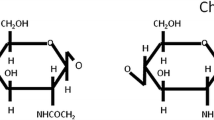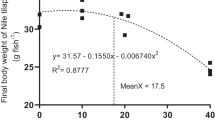Abstract
Myofibrillar protein are the principally responsible of gelling properties in fishery resource, hence, during protein concentrate or isolated proteins preparation, sarcoplasmic protein are discarded; however, myofibrillar protein can support low levels of sarcoplasmic proteins without affecting the gelling property. Therefore, the aim of this study was to gradually remove sarcoplasmic proteins from giant squid mantle by means of different ionic strengths (I). Solutions of NaCl with different ionic strengths (I=0.0, 0.1, and 0.3) were used to obtain 3 protein concentrates. The electrophoretic profile in SDS-PAGE showed differences in protein removal with a high solubility of mantle proteins. The texture profile analysis showed that hardness increased in mantle protein washed with higher I. The total reactive sulfhydryls showed significant changes (p<0.05) detecting major formation of S-S bonds with protein removal at an I of 0.3. Differential scanning calorimetry showed a minor denaturation temperature of the actomyosin complex when protein removal was performed with an I of 0.3. The present study indicates that removal of sarcoplasmic protein as a function of I results in better quality gels.
Similar content being viewed by others
References
Cortés-Ruiz J, Pacheco-Aguilar R, Lugo-Sánchez M, Carvallo-Ruiz G, García-Sánchez G. Production and functional evaluation of a protein concentrate from giant squid (Dosidicus gigas) by acid dissolution and isoelectric precipitation. Food Chem. 110: 486–492 (2008)
Velázquez G, Miranda P, López G, Vázquez M, Torres JA, Ramírez JA. Effect of recovered soluble proteins from Pacific whiting surimi wash water on the functional and mechanical properties of Alaska pollock surimi grade FA. Ciencia y Tecnologia Alimentaria. 5(5): 340–345 (2007)
Sánchez AI, Careche M, Borderías AJ. Method for producing a functional protein concentrate from giant squid (Dosidicus gigas) muscle. Food Chem. 100: 48–54. 2007.
AOAC. Official Methods of Analysis. 15th ed. Association of Official Analytical Chemists, Arlington, VA, USA (1996)
Lanier T. Measurement of surimi composition and functional properties. pp. 123–163. In: Surimi Technology. Lanier TC, Lee C (eds). Marcel Dekker, New York, NY, USA (1992)
Tanikawa E, Motohiro T, Akiba M. Marine Products in Japan. Revised ed. Koseisha Koseikaku Co., Ltd., Tokyo, Japan. p. 506 (1985)
Kato A, Nakai S. Hydrophobicity determined by a fluorescence probe method and its correlation with surface properties of proteins. Biochim. Biophys. Acta 624: 13–20 (1980)
Patrick PS, Swaisgood HE. Sulfhydryl and disulfide groups in skim milk as affected by direct ultra-high-temperatures heating and subsequent storage. J. Dairy Sci. 59: 594–600 (1976)
Paredi ME, Tomas MC, Crupkin M, Añón MC. Thermal denaturation of Aulacomya ater ater (Molina) myofibrillar proteins: A differential scanning calorimetric study. J. Agr. Food Chem. 42: 873–877 (1994)
Dihort-Garcia G, Ocano-Higuera VM, Ezquerra-Brauer JM, Lugo-Sanchez ME, Pacheco-Aguilar R, Barrales-Heredia SM, Marquez-Rios E. Production and functional evaluation of a protein concéntrate from giant squid (Dosidicus gigas) obtained by alkaline disolution. CyTA-J. Food. 9: 171–179 (2011)
Gómez-Guillén C, Solas T, Borderías J, Montero MP. Effect of heating temperature and sodium chloride concentration on ultrastructure and texture of gels made from giant squid (Dosidicus gigas) with addition of starch, i-carrageenan and egg white. Z. Lebensm. Unters. For. 202: 221–227 (1996)
Choi YJ, Park JW. Acid-aided protein recovery from enzyme-rich pacific whiting. J. Food Sci. 67: 2962–2967 (2002)
Kristinsson HG, Demir N. Functional fish protein ingredients from fish species of warm and temperate waters: Comparison of acid and alkali-aided processing vs. conventional surimi processing. pp. 277–295. In: Advances in Seafood Byproducts. Bechtel P. (ed). University of Alaska Press. Fairbanks, AK, USA (2003)
Batista I, Pires C, Nellhas R. Extraction of sardine proteins by acidic and alkaline solubilisation. Food Sci. Int. 13(3): 189–194 (2007)
Cardamone M, Puri NK. Spectrofluorimetric assessment of the surface hydrophobicity of proteins. Biochem. J. 282: 589–593 (1992)
Wang H, Pato M, Pietrasik Z, Shand P. Biochemical and physicochemical properties of thermally treated natural actomyosin extracted from normal and PSE pork Longissimus muscle. Food Chem. 113: 21–27 (2009)
Yongsawatdigul J, Park JW. Thermal denaturation and aggregation of threadfin bream actomyosin. Food Chem. 83: 409–416 (2003)
Viseesanguan W, Ogawa M, Nakai S, An H. Physicochemical changes and mechanism of heat-induced gelation of arrowtooth flounder myosin. J. Agr. Food Chem. 48: 1016–1023 (2000)
Riebroy S, Benjakul S, Visessanguan W, Erikson U, Rustad T. Acidinduced gelation of natural actomyosin from atlantic cod (Gadus morhua) and burbot (Lota lota) Food Hydrocolloid. 23: 26–39 (2009)
Wen-Ching K, Chi-Cheng Y, Kuo-Chiang H. Changes in conformation and sulfhydryl groups of tilapia actomyosin by thermal treatment. LWT-Food Sci. Technol. 40: 1316–1320 (2007)
Sano T, Ohno T, Otsuka-Fuchino H, Matsumoto JJ, Tsuchiya T. Carp natural actomyosin: Thermal denaturation mechanism. J. Food Sci. 59: 1002–1008 (1994)
Latif T, Yi-Chen C, Jacek J. Functional properties of proteins recovered from silver carp (Hypophthalmichthys molitrix) by isoelectric solubilization/precipitation. LWT-Food Sci. Technol. 42: 1082–1089 (2009)
Raghavan S, Kristinsson HG. Conformational and rheological changes in catfish myosin as affected by different acids during acid-induced unfolding and refolding. J. Agr. Food Chem. 55: 4144–4153 (2007)
Thorarinsdottir KA, Arason S, Geirsdottir M, Bogason SG, Kristbergsson K. Changes in myofibrillar proteins during processing of salted cod (Gardus morhua) as determined by electrophoresis and differential scanning calorimetry. Food Chem. 77: 377–385 (2002)
Rodger G, Weddle RB, Craig P, Hastings R. Effect of alkaline protease activity on some properties of comminuted squid. J. Food Sci. 49: 117–123 (1984)
Hastings R, Rodger GW, Park R, Matthews AD, Anderson EM. Differential scanning calorimetry of fish muscle: The effect of processing and species variation. J. Food Sci. 50: 1503–1510 (1985)
Howell BK, Matthews AD, Donnelly AP. Thermal stability of fish myofibrils a differential scanning calorimetric study. Int. J. Food Sci. Tech. 26: 283–295 (1991)
Paredi ME, Tomas MC, Crupkin M. Thermal denaturation of myofibrillar proteins of striated and smooth adductor muscles of scallop (Zygochlamys patagonica) A differential scanning calorimetric study. J. Agr. Food Chem. 50: 830–834 (2002)
Author information
Authors and Affiliations
Corresponding author
Rights and permissions
About this article
Cite this article
Encinas-Arzate, J.d.J., Ezquerra-Brauer, J.M., Ocaño-Higuera, V.M. et al. Effect of ionic strength on soluble protein removal from giant squid mantle (Dosidicus gigas) and functional evaluation of protein recovery. Food Sci Biotechnol 23, 401–407 (2014). https://doi.org/10.1007/s10068-014-0055-y
Received:
Revised:
Accepted:
Published:
Issue Date:
DOI: https://doi.org/10.1007/s10068-014-0055-y




